28 Metaphors About Myself: A Comprehensive Guide
Understanding metaphors is crucial for mastering figurative language and enriching your communication skills. This article delves into the specific use of metaphors to describe oneself, exploring their structure, types, and applications.
By learning to identify and create self-referential metaphors, you can express complex emotions and ideas in a creative and impactful way. This guide is designed for English language learners of all levels, from beginners seeking to grasp basic concepts to advanced speakers aiming to refine their expressive abilities.
Table of Contents
- Introduction
- Definition of Metaphor
- Structural Breakdown of Self-Referential Metaphors
- Types and Categories of Metaphors About Myself
- Examples of Metaphors About Myself
- Usage Rules for Self-Referential Metaphors
- Common Mistakes When Using Metaphors About Myself
- Practice Exercises
- Advanced Topics in Self-Referential Metaphors
- Frequently Asked Questions
- Conclusion
Introduction
Metaphors are powerful tools in the English language, allowing us to express abstract ideas and emotions in vivid and relatable ways. When used to describe ourselves, metaphors offer a unique lens through which we can explore our identities, strengths, and weaknesses.
Understanding how to craft and interpret these self-referential metaphors is essential for effective communication and self-expression. This article provides a comprehensive guide to using metaphors about oneself, covering everything from basic definitions to advanced techniques.
This guide is structured to provide a clear and progressive understanding of metaphors about oneself. We will begin by defining what a metaphor is and its fundamental components.
From there, we will delve into the structural aspects of self-referential metaphors, examining how they are constructed and what makes them effective. We will also explore different types of metaphors commonly used to describe oneself, providing numerous examples to illustrate each category.
Finally, we’ll cover rules, common mistakes, and offer practice exercises to solidify your understanding.
Whether you’re a student looking to improve your writing skills, a professional seeking to enhance your communication, or simply someone interested in exploring the nuances of language, this article will provide you with the knowledge and tools you need to master the art of using metaphors about yourself. By the end of this guide, you will be able to confidently identify, analyze, and create compelling metaphors that accurately reflect your inner world and communicate your unique perspective to others.
Definition of Metaphor
A metaphor is a figure of speech that directly compares two unrelated things without using “like” or “as.” It asserts that one thing *is* another, not literally, but for the purpose of highlighting a shared quality or characteristic. This comparison allows us to understand something unfamiliar or abstract in terms of something more concrete and familiar.
Unlike similes, which use “like” or “as” to make a comparison (e.g., “He is *as brave as a lion*”), metaphors make a direct equation (e.g., “He *is* a lion”). This directness gives metaphors a stronger and often more impactful effect.
The key components of a metaphor are thetenor(the subject being described), thevehicle(the object or concept used to describe the tenor), and theground(the shared characteristic between the tenor and the vehicle). Understanding these components helps in both analyzing and constructing effective metaphors.
For example, in the metaphor “I am an island,” “I” is the tenor, “island” is the vehicle, and the shared characteristic of being isolated or self-contained is the ground.
Structural Breakdown of Self-Referential Metaphors
Self-referential metaphors, as the name suggests, are metaphors where the tenor is the speaker or writer themselves. These metaphors offer a unique way to express personal qualities, experiences, and emotions.
The structure of these metaphors typically involves identifying a salient characteristic of oneself and then finding a vehicle that shares that characteristic.
The basic formula for constructing a self-referential metaphor is: “I am [vehicle]” or “[Vehicle] is what I am.” However, the effectiveness of the metaphor relies on the clarity and relevance of the implied comparison. The vehicle should be carefully chosen to resonate with the intended meaning and evoke a specific image or emotion in the audience.
Consider the metaphor “I am a work in progress.” Here, the tenor is “I,” the vehicle is “work in progress,” and the ground is the idea of being incomplete, constantly evolving, and subject to change. This metaphor effectively communicates a sense of humility and openness to growth.
More complex self-referential metaphors might involve extended comparisons or multiple vehicles. For instance, “I am a tangled forest, full of hidden paths and unexpected clearings,” uses the vehicle of a “tangled forest” to convey a sense of complexity, mystery, and unexplored potential within the speaker’s personality.
These extended metaphors can offer a richer and more nuanced portrayal of the self.
Types and Categories of Metaphors About Myself
Metaphors can be categorized in various ways based on their structure, function, and the type of comparison they make. Understanding these categories can help you choose the most effective metaphor for expressing a particular aspect of yourself.
Structural Metaphors
Structural metaphors organize one concept in terms of another. These metaphors provide a framework for understanding a complex or abstract idea by relating it to something more familiar and concrete.
When used to describe oneself, structural metaphors can reveal how we conceptualize our experiences and relationships.
For example, the metaphor “My life is a journey” is a structural metaphor that frames life as a linear progression with a starting point, a destination, and various obstacles and opportunities along the way. This framework can influence how we approach our goals and view our past experiences.
Orientational Metaphors
Orientational metaphors use spatial relationships (up-down, in-out, front-back) to describe abstract concepts. These metaphors are often rooted in physical experiences and cultural conventions.
When applied to self-description, orientational metaphors can reveal our attitudes and values.
Consider the metaphor “I am feeling down.” This orientational metaphor associates sadness with the downward direction, reflecting the common cultural understanding of happiness as “up” and sadness as “down.” Similarly, “I am on top of the world” uses the upward direction to express feelings of success and joy.
Ontological Metaphors
Ontological metaphors treat abstract concepts as concrete entities, allowing us to quantify, identify, and reason about them. These metaphors often involve personification, where inanimate objects or abstract ideas are given human qualities.
When used to describe oneself, ontological metaphors can highlight specific traits or characteristics.
For example, “I am a fountain of ideas” treats the abstract concept of ideas as a tangible substance flowing from the speaker. This metaphor emphasizes the speaker’s creativity and ability to generate new thoughts.
Another example is “I am a fortress,” which treats the speaker as a physical structure, highlighting their resilience and ability to withstand challenges.
Implicit vs. Explicit Metaphors
Metaphors can also be classified as either implicit or explicit. Explicit metaphors clearly state the comparison between the tenor and the vehicle, often using verbs like “is” or “are.” Implicit metaphors, on the other hand, imply the comparison without directly stating it. They require the audience to infer the connection between the tenor and the vehicle.
An example of an explicit self-referential metaphor is “I am an open book.” The comparison between the speaker and an open book is directly stated. In contrast, an implicit metaphor might be “My pages are worn and dog-eared,” which implies that the speaker is like a well-read book without explicitly stating the comparison.
Implicit metaphors can be more subtle and require greater interpretive skill, but they can also be more evocative and engaging.
Examples of Metaphors About Myself
The following tables provide extensive examples of metaphors used to describe oneself, categorized by the type of quality or characteristic they convey. These examples are designed to inspire you and provide a starting point for creating your own unique self-referential metaphors.
The first table focuses on metaphors that describe personality traits. These examples use various vehicles to convey different aspects of character, such as introversion, extroversion, resilience, and sensitivity.
By examining these examples, you can gain a better understanding of how to choose vehicles that accurately reflect your own personality traits.
| Category | Metaphor | Explanation |
|---|---|---|
| Introversion | I am a quiet pond, reflecting the world around me. | Conveys a sense of introspection and calmness. |
| Extroversion | I am a roaring waterfall, full of energy and enthusiasm. | Highlights a vibrant and outgoing personality. |
| Resilience | I am a sturdy oak, weathering every storm. | Emphasizes strength and the ability to endure challenges. |
| Sensitivity | I am a delicate flower, easily bruised by harsh words. | Conveys vulnerability and empathy. |
| Creativity | I am a canvas waiting to be painted. | Emphasizes potential and the desire to create. |
| Stubbornness | I am a mule, unwavering in my convictions. | Highlights determination, but also potential inflexibility. |
| Adaptability | I am a chameleon, blending into new environments. | Conveys the ability to adjust to different situations. |
| Curiosity | I am a cat, always exploring new corners. | Emphasizes inquisitiveness and a desire for knowledge. |
| Patience | I am a slow-burning candle, radiating warmth over time. | Highlights the ability to wait and persevere. |
| Impulsivity | I am a shooting star, burning brightly but fading quickly. | Conveys a tendency to act without thinking. |
| Organized | I am a well-oiled machine, efficient and precise. | Highlights structure and attention to detail. |
| Chaotic | I am a tornado, unpredictable and full of energy. | Conveys a lack of structure and a tendency towards disorder. |
| Optimistic | I am a sunrise, bringing hope and new beginnings. | Highlights a positive outlook and belief in the future. |
| Pessimistic | I am a raincloud, casting shadows on everything I see. | Conveys a negative outlook and a tendency to focus on the bad. |
| Loyal | I am a golden retriever, always by your side. | Emphasizes faithfulness and dedication. |
| Independent | I am a lone wolf, forging my own path. | Highlights self-reliance and a desire for autonomy. |
| Forgiving | I am a flowing river, washing away past hurts. | Conveys the ability to let go of resentment. |
| Judgmental | I am a hawk, always watching and assessing. | Highlights a tendency to criticize and evaluate others. |
| Confident | I am a mountain, standing tall and unwavering. | Emphasizes self-assurance and belief in one’s abilities. |
| Insecure | I am a house of cards, easily toppled by doubt. | Conveys a lack of self-confidence and vulnerability. |
| Dreamer | I am a kite dancing in the wind, soaring towards the sky. | Highlights ambition and aspirations. |
| Perfectionist | I am a clock, ticking with precision and accuracy. | Conveys a desire for flawlessness and order. |
The next table provides metaphors related to emotional states. Describing emotions can be challenging, and metaphors offer a powerful way to convey the intensity and complexity of feelings.
These examples use vehicles such as weather phenomena, natural landscapes, and physical sensations to express emotions like joy, sadness, anger, and fear.
| Category | Metaphor | Explanation |
|---|---|---|
| Joy | I am a burst of sunshine, warming everything around me. | Conveys a feeling of happiness and radiance. |
| Sadness | I am a heavy raincloud, shedding tears of sorrow. | Highlights a feeling of grief and despair. |
| Anger | I am a raging fire, consuming everything in its path. | Emphasizes the intensity and destructiveness of anger. |
| Fear | I am a trapped bird, fluttering against the cage of my anxieties. | Conveys a feeling of helplessness and panic. |
| Love | I am a warm embrace, offering comfort and security. | Highlights the nurturing and protective aspects of love. |
| Anxiety | I am a tightrope walker, balancing precariously over an abyss. | Conveys a feeling of unease and instability. |
| Hope | I am a tiny seed, waiting to blossom into something beautiful. | Emphasizes potential and anticipation for the future. |
| Despair | I am a barren wasteland, devoid of life and hope. | Conveys a feeling of emptiness and hopelessness. |
| Excitement | I am a roller coaster, climbing high and plunging down. | Highlights the thrill and unpredictability of excitement. |
| Boredom | I am a ticking clock, marking the slow passage of time. | Conveys a feeling of monotony and lack of stimulation. |
| Gratitude | I am a sunflower, turning my face towards the light. | Highlights appreciation and thankfulness. |
| Jealousy | I am a green-eyed monster, consumed by envy and resentment. | Conveys the destructive nature of jealousy. |
| Loneliness | I am a solitary island, surrounded by a vast ocean. | Highlights isolation and a lack of connection. |
| Peace | I am a still lake, reflecting the tranquility of the sky. | Conveys a feeling of calmness and serenity. |
| Regret | I am a ghost, haunted by the mistakes of the past. | Highlights remorse and a longing for what could have been. |
| Shame | I am a shadow, hiding from the light of day. | Conveys a feeling of humiliation and guilt. |
| Surprise | I am a jack-in-the-box, suddenly springing open. | Highlights the unexpected and startling nature of surprise. |
| Trust | I am a steady hand, offering support and reliability. | Conveys confidence and faith in others. |
| Vulnerability | I am a soft underbelly, exposed and unprotected. | Highlights openness and susceptibility to harm. |
| Wonder | I am a child, gazing at the stars with awe and fascination. | Conveys a sense of amazement and curiosity. |
| Contentment | I am a purring cat, basking in the warmth of the sun. | Highlights satisfaction and ease. |
| Frustration | I am a tangled knot, difficult to unravel. | Conveys a feeling of being stuck and unable to progress. |
The third table focuses on metaphors for life stages and experiences. These metaphors use vehicles related to nature, construction, and journeys to describe different phases of life, challenges, and achievements.
These examples can help you articulate your personal journey and reflect on your growth and development.
| Category | Metaphor | Explanation |
|---|---|---|
| Childhood | I am a sapling, reaching for the sun. | Conveys a sense of growth and potential. |
| Adolescence | I am a turbulent sea, full of uncertainty and change. | Highlights the emotional intensity and challenges of adolescence. |
| Adulthood | I am a sturdy bridge, connecting the past and the future. | Emphasizes responsibility and stability. |
| Old Age | I am a wise old tree, bearing the marks of time. | Conveys a sense of experience and wisdom. |
| Challenges | I am a steep mountain, difficult to climb but rewarding at the summit. | Highlights the effort and perseverance required to overcome obstacles. |
| Achievements | I am a soaring eagle, reaching new heights. | Emphasizes success and accomplishment. |
| Failure | I am a broken vase, shattered into pieces. | Conveys a feeling of loss and disappointment. |
| Learning | I am a sponge, absorbing new information. | Highlights the ability to acquire knowledge. |
| Growth | I am a butterfly, emerging from its chrysalis. | Emphasizes transformation and development. |
| Relationships | I am a woven tapestry, intertwined with the lives of others. | Conveys the interconnectedness of human relationships. |
| Career | I am a climbing vine, slowly but surely reaching the top. | Highlights progress and ambition in one’s profession. |
| Education | I am a library, filled with knowledge and stories. | Conveys the vastness and richness of learning. |
| Friendship | I am a warm fire, providing comfort and companionship. | Highlights the supportive and nurturing aspects of friendship. |
| Healing | I am a gentle breeze, soothing the wounds of the past. | Conveys the process of recovery and restoration. |
| Loss | I am an empty chair, a reminder of someone who is gone. | Highlights the absence and grief associated with loss. |
| Memory | I am a scrapbook, filled with cherished moments and experiences. | Conveys the importance of remembering and preserving the past. |
| Purpose | I am a guiding star, leading others towards their destination. | Highlights a sense of direction and meaning in life. |
| Resilience | I am a bamboo tree, bending in the wind but never breaking. | Conveys the ability to withstand adversity and bounce back. |
| Spirituality | I am a quiet temple, a place of reflection and peace. | Highlights a connection to something greater than oneself. |
| Time | I am a flowing river, constantly moving forward. | Conveys the relentless and irreversible nature of time. |
| Change | I am a flowing river, constantly adapting to new landscapes. | Highlights the inevitable and continuous nature of change. |
| Legacy | I am a planted seed, promising future growth. | Conveys the lasting impact one hopes to have on the world. |
Usage Rules for Self-Referential Metaphors
While metaphors are creative and expressive, there are certain rules to follow to ensure clarity and effectiveness. These rules focus on relevance, consistency, and avoiding mixed metaphors.
Relevance:The vehicle of your metaphor should be relevant to the characteristic you are trying to convey. The connection between the tenor (you) and the vehicle should be clear and logical.
Avoid using vehicles that are too obscure or unrelated to the intended meaning.
Consistency:Maintain consistency in your metaphor. If you start with one vehicle, stick with it throughout your description.
Avoid abruptly switching to a different vehicle that clashes with the original one. This can create confusion and weaken the impact of your metaphor.
Avoiding Mixed Metaphors:A mixed metaphor combines two or more unrelated metaphors, creating a nonsensical or contradictory image. For example, “I am a roaring fire, but also a blank page” is a mixed metaphor because the image of a roaring fire clashes with the image of a blank page.
Be mindful of the images you are creating and ensure they are cohesive and logical.
Consider Your Audience:When crafting metaphors, consider your audience and their level of understanding. Choose vehicles that are familiar and relatable to your audience.
Avoid using overly complex or obscure metaphors that may be difficult for them to interpret. The goal is to communicate effectively, so prioritize clarity and accessibility.
Common Mistakes When Using Metaphors About Myself
Using metaphors effectively takes practice, and it’s common to make mistakes along the way. Here are some frequent errors to watch out for:
Clichés:Overused metaphors, known as clichés, can sound unoriginal and lack impact. Examples include “I am an open book” or “I am a diamond in the rough.” While these metaphors are easily understood, they lack the freshness and creativity of original metaphors.
Try to find more unique and imaginative ways to express yourself.
Overly Complex Metaphors: While complex metaphors can be powerful, they can also be confusing if they are too convoluted or obscure. Ensure that your metaphor is clear and easy to understand, even if it involves multiple layers of meaning.
Inconsistent Tone:The tone of your metaphor should be consistent with the overall tone of your writing or speech. Avoid using a metaphor that clashes with the mood or style of your communication.
For example, a humorous metaphor might be inappropriate in a serious or somber context.
Misunderstanding the Vehicle:Ensure you have a thorough understanding of the vehicle you are using in your metaphor. If you misinterpret the characteristics or qualities of the vehicle, your metaphor may not convey the intended meaning.
Do your research and choose vehicles that you are familiar with.
Here are some examples of common mistakes with corrections:
| Mistake | Correction | Explanation |
|---|---|---|
| I’m a rolling stone gathering momentum. | I’m a river, constantly carving a new path. | “Rolling stone” is a cliché; the correction offers a fresher image. |
| I am a roaring fire, but my roots are firmly planted. | I am a volcano, powerful and ready to erupt. | The original is a mixed metaphor; the correction maintains a single, consistent image. |
| I am an intricate algorithm, calculating every move. | I am a chess player, strategizing my next move. | The original is overly complex; the correction is more accessible and relatable. |
Practice Exercises
These exercises will help you practice identifying, analyzing, and creating metaphors about yourself. Each exercise focuses on a different aspect of metaphor usage, from recognizing metaphors in context to crafting your own original self-descriptions.
Exercise 1: Identifying Metaphors
Read the following sentences and identify the metaphors used to describe the speaker. Explain the tenor, vehicle, and ground of each metaphor.
| Question | Answer |
|---|---|
| 1. I am a compass, always pointing towards my true north. | Tenor: I; Vehicle: Compass; Ground: Guidance, direction |
| 2. My heart is a garden, filled with blooming flowers and thorny weeds. | Tenor: My heart; Vehicle: Garden; Ground: Emotions, experiences |
| 3. I am a lighthouse, guiding others through stormy seas. | Tenor: I; Vehicle: Lighthouse; Ground: Guidance, safety |
| 4. My mind is a labyrinth, full of winding paths and hidden chambers. | Tenor: My mind; Vehicle: Labyrinth; Ground: Complexity, mystery |
| 5. I am a phoenix, rising from the ashes of my past. | Tenor: I; Vehicle: Phoenix; Ground: Renewal, resilience |
| 6. I am a musical instrument, playing a unique tune. | Tenor: I; Vehicle: Musical instrument; Ground: Individuality, expression |
| 7. My dreams are stars, illuminating the darkness of night. | Tenor: My dreams; Vehicle: Stars; Ground: Hope, inspiration |
| 8. I am a sculptor, molding my life into a work of art. | Tenor: I; Vehicle: Sculptor; Ground: Creativity, self-improvement |
| 9. My words are seeds, planting ideas in the minds of others. | Tenor: My words; Vehicle: Seeds; Ground: Influence, impact |
| 10. I am a river, flowing towards the ocean of my destiny. | Tenor: I; Vehicle: River; Ground: Progress, purpose |
Exercise 2: Completing Metaphors
Complete the following sentences by adding a vehicle to create a metaphor about yourself. Explain the ground of your metaphor.
| Question | Answer |
|---|---|
| 1. I am as reliable as a _____. | I am as reliable as a grandfather clock. Ground: Consistency, dependability. |
| 2. My spirit is like a _____. | My spirit is like a kite in the wind. Ground: Freedom, resilience. |
| 3. I am a _____, full of hidden depths. | I am a deep ocean, full of hidden depths. Ground: Mystery, complexity. |
| 4. My potential is a _____, waiting to be unlocked. | My potential is a treasure chest, waiting to be unlocked. Ground: Hidden value, opportunity. |
| 5. I am a _____, always seeking new adventures. | I am a traveler, always seeking new adventures. Ground: Curiosity, exploration. |
| 6. My determination is a _____, never giving up. | My determination is a marathon runner, never giving up. Ground: Persistence, endurance. |
| 7. I am a _____, bringing light to dark places. | I am a lantern, bringing light to dark places. Ground: Hope, guidance. |
| 8. My creativity is a _____, constantly flowing. | My creativity is a waterfall, constantly flowing. Ground: Abundance, energy. |
| 9. I am a _____, protecting those I love. | I am a shield, protecting those I love. Ground: Support, defense. |
| 10. My heart is a _____, always open to new experiences. | My heart is a door, always open to new experiences. Ground: Welcoming, receptive. |
Exercise 3: Creating Original Metaphors
Write five original metaphors about yourself, each describing a different aspect of your personality, emotions, or life experiences. Explain the tenor, vehicle, and ground of each metaphor.
| Question | Answer |
|---|---|
| 1. Describe your sense of humor. | I am a rubber chicken, always ready to lighten the mood. Tenor: I; Vehicle: Rubber chicken; Ground: Playfulness, silliness. |
| 2. Describe your approach to challenges. | I am a mountain climber, tackling each obstacle with determination. Tenor: I; Vehicle: Mountain climber; Ground: Perseverance, resilience. |
| 3. Describe your relationship with knowledge. | I am a sponge, soaking up every drop of information I can find. Tenor: I; Vehicle: Sponge; Ground: Curiosity, learning. |
| 4. Describe your emotional state when you are stressed. | I am a pressure cooker, building up steam until I need to release it. Tenor: I; Vehicle: Pressure cooker; Ground: Tension, anxiety. |
| 5. Describe your personal growth over time. | I am a tree, growing stronger and taller with each passing year. Tenor: I; Vehicle: Tree; Ground: Development, resilience. |
Advanced Topics in Self-Referential Metaphors
For advanced learners, exploring the use of extended metaphors and analyzing literary examples can further enhance your understanding and skill in using self-referential metaphors.
Extended Metaphors:An extended metaphor is a metaphor that is sustained over several lines or even an entire piece of writing. It allows for a more detailed and nuanced exploration of the comparison between the tenor and the vehicle.
When using extended metaphors to describe yourself, you can create a richer and more compelling portrait of your inner world.
Literary Analysis:Analyzing how famous authors use self-referential metaphors in their works can provide valuable insights into the art of crafting effective metaphors. Pay attention to the vehicles they choose, the images they evoke, and the overall impact of their metaphors on the reader.
Consider exploring works by poets like Sylvia Plath or novelists like Virginia Woolf, who are known for their evocative use of figurative language.
Creating Unique Vehicles:Challenge yourself to find unconventional and unexpected vehicles for your metaphors. The more original your vehicle, the more likely you are to create a memorable and impactful metaphor.
Think outside the box and draw inspiration from unusual sources, such as science, history, or mythology.
Frequently Asked Questions
- What is the difference between a metaphor and a simile?
A metaphor directly equates two unlike things, stating that one *is* the other (e.g., “He is a lion”). A simile, on the other hand, uses “like” or “as” to make a comparison (e.g., “He is like a lion”). Metaphors are generally considered stronger and more direct.
- How can I avoid using clichés in my metaphors?
To avoid clichés, focus on finding fresh and original comparisons. Brainstorm different vehicles that relate to the characteristic you want to convey and choose the one that is most unique and unexpected. Use a thesaurus to find alternative words and phrases that can help you express your ideas in a more creative way.
- What if my metaphor is too complex for my audience to understand?
If you suspect your metaphor may be too complex, try breaking it down into simpler components. Explain the connection between the tenor and the vehicle more explicitly. Alternatively, you can choose a simpler and more relatable vehicle that is easier for your audience to grasp.
- Can I use multiple metaphors to describe myself?
Yes, you can use multiple metaphors to describe yourself, but be sure to maintain consistency and avoid mixed metaphors. Each metaphor should focus on a different aspect of your personality, emotions, or experiences. Ensure that the metaphors work together to create a cohesive and coherent portrait of yourself.
- How can I improve my ability to create effective metaphors?
Practice is key to improving your ability to create effective metaphors. Read widely, pay attention to the metaphors used by other writers and speakers, and experiment with different vehicles and comparisons. The more you practice, the better you will become at finding creative and impactful ways to express yourself.
- Are there any cultural considerations when using metaphors?
Yes, metaphors can be culturally specific, and what resonates in one culture may not resonate in another. Be mindful of your audience and choose vehicles that are familiar and relevant to their cultural background. Avoid using metaphors that may be offensive or insensitive in certain cultures.
- How do I choose the right metaphor to represent myself?
Think about the core qualities, experiences, and values that define you. Consider what aspects of yourself you want to highlight. Then, brainstorm vehicles that share similar characteristics. The most effective metaphors will be both accurate and evocative, capturing the essence of who you are in a memorable way.
Conclusion
Mastering the art of using metaphors about oneself is a valuable skill that can enhance your communication, self-expression, and overall understanding of language. By understanding the structure, types, and usage rules of self-referential metaphors, you can craft compelling and insightful descriptions of yourself that resonate with your audience.
Remember to practice regularly, experiment with different vehicles, and always consider your audience when creating metaphors. With dedication and creativity, you can unlock the power of metaphors to express your unique perspective and connect with others on a deeper level.







